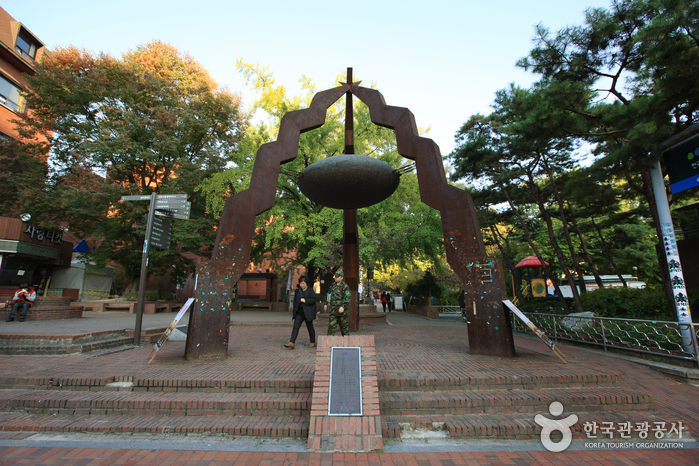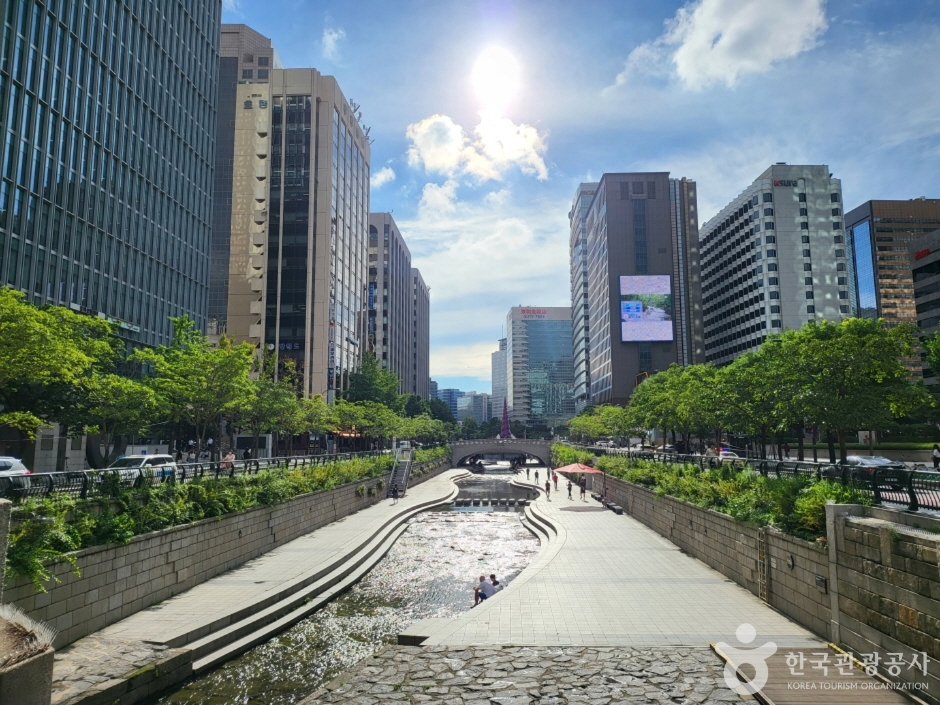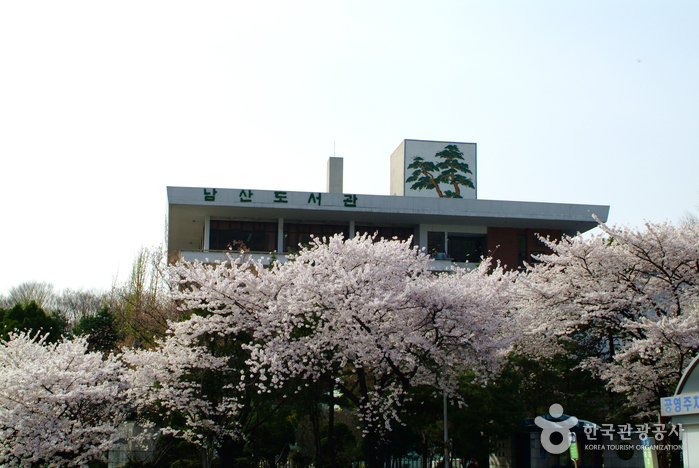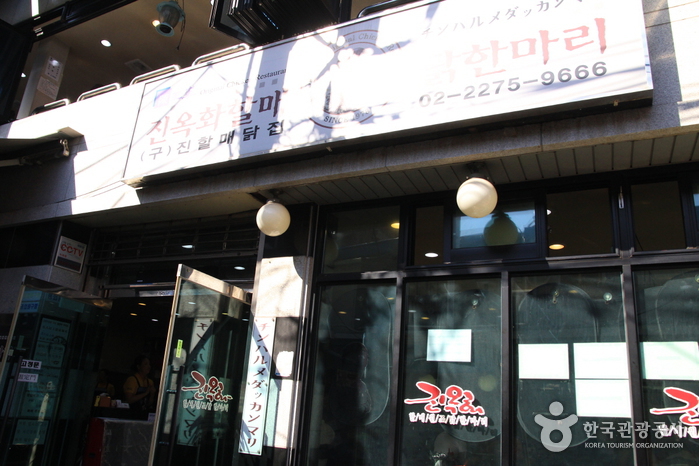Parque Marronnier (마로니에공원)
2.1Km 2021-07-07
Daehak-ro 104, Jongno-gu, Seúl.
El parque Marronnier tiene en su centro un árbol “marronnier” (castaño de Indias –Aesculus-) simbólico, y en el área se congregan toda clase de centros de eventos culturales al aire libre, exhibiciones de escultura y centros de arte. El área comenzó a desarrollarse en 1975, cuando la Universidad Nacional de Seúl fue trasladada aquí, y unos 50 teatros pequeños y 500 cafés concentrados en el área hicieron a este lugar un sitio de reunión y relajación enormemente querido por los jóvenes y ancianos por igual. El parque se vuelve especialmente concurrido los fines de semana, cuando las multitudes se congregan para compartir los eventos culturales. Las bandas y los cantantes, así como los grupos de baile y los comediantes se reúnen y dan actuaciones in situ. Los adivinos y los artistas callejeros también se hallan aquí y le dicen su fortuna o le dibujan retratos. El parque tiene muchos árboles y bancos para sentarse y relajarse, convirtiéndolo en el lugar ideal para la relajación y los paseos pausados. El parque Marronnier es una parte de Daehangno, la famosa calle conocida como la “meca de las obras”. Además de las obras, aquí hay muchas actuaciones culturales y restaurantes interesantes y cafés que hacen de este lugar el destino habitual de reunión favorito de muchos jóvenes.
Arroyo Cheonggyecheon (청계천)
2.1Km 2025-09-15
Changsin-dong, Jongno-gu, Seúl
El arroyo Cheonggyecheon nace en la plaza Cheonggye, que se encuentra en la avenida Sejong-ro, frente al edificio del periódico Donga Ilbo, que fue el lugar de inicio del restablecimiento del arroyo. Abarca hasta el puente Sindapcheolgyo. La plaza Cheonggye se compone de una fuente con caídas de agua, un modelo en miniatura del arroyo en su totalidad y una senda de paseos, entre otras instalaciones para comodidad de los visitantes.
El diseño de la plaza Cheonggye presenta un toque tradicional, el lugar está decorado con colores diversos, ofreciendo una elegancia peculiar. El modelo del arroyo representado en tamaño de miniatura, posibilita a simple vista recorrer la zona completa del arroyo remodelado. También expone los carteles explicativos de los 22 puentes que atraviesan el curso de agua y otros detalles. Por otra parte, hacia la izquierda está instalada la escalera que conecta con las aceras ribereñas del arroyo y hacia la derecha de la plaza Cheonggye hay un sendero con un túnel de 18 m de largo.
El Ayuntamiento de Seúl ha logrado que el lugar se convierta en un espacio cultural libre para los ciudadanos, prohibiendo el tránsito de vehículos en los días festivos. La fuente con forma de candelero y con la iluminación de luces tricolores, junto a las caídas de agua desde dos pisos, a una altura de 4 m, conforman una obra de ingeniería civil maravillosa. A cada lado de las caídas de agua se han instalado miles de piedras traídas desde todas partes del país. Por la noche, la combinación que hace el agua con las luces de la iluminación es realmente un espectáculo fantástico.
Biblioteca Namsan (서울특별시교육청 남산도서관)
2.1Km 2021-03-13
Sowol-ro 109, Yongsan-gu, Seúl.
La Biblioteca Namsan se inauguró como una biblioteca pública en 1922 en el barrio de Myeong-dong, en Seúl. En 1964 se trasladó al sitio actual y en el año siguiente obtuvo el actual nombre. Cuenta con 19 salas con diferentes materiales, entre ellos están la Sala de Humanidades, la Sala de Ciencias Naturales, la Sala de Letras y Literatura, la Sala de Publicaciones Periódicas y la Sala de Archivos Electrónicos. La colección está conformada por 500.000 libros, 16.000 artículos de otro tipo y 700 publicaciones periódicas.
Asimismo, desde 2005, está expandiendo su área más allá de lo común con el proyecto de curar con lectura, para lo cual se hizo una remodelación de la sala de asesoría de lectura y se están realizando talleres de capacitación de los encargados del proyecto de curar con lectura, talleres, programas de cura para individuos y grupos, etc. Además de estos planes, organiza a lo largo del año varias exhibiciones, clases, reuniones de lectura, cursos de temas profesionales, aula cultural, etc., con el objetivo de ser un espacio educativo de carácter permanente para los ciudadanos.
Chosochaekbang Deosup del Monte Inwangsan (인왕산 더숲 초소책방)
2.2Km 2025-04-18
Inwangsan-ro 172, Jongno-gu, Seúl
Jinokhwa Halmae Wonjo Dakhanmari (Jin Ok-hwa Original Chicken Restaurant) (진옥화할매원조닭한마리)
2.2Km 2024-11-28
18, Jong-ro 40ga-gil, Jongno-gu, Seoul
+82-2-2275-9666
Jinokhwa Halmae Wonjo Dakhanmari first opened its doors in 1978 and has continued to be a much-loved restaurant on Jongno 5-ga for the past 30 years. The restaurant only uses fresh young chickens, which are about 35 days old, and minimal seasoning to allow diners to fully enjoy the tenderness of the meat. Dip your chicken in the special marinade sauce and couple it with a helping of Kalguksu (a noodle dish) for a perfect meal combination.
Teatro ARKO (아르코예술극장)
2.2Km 2025-09-15
Daehak-ro 8-gil 7, Jongno-gu, Seúl.
Teatro de Arte Daehangno (대학로예술극장)
2.3Km 2021-04-23
Daehak-ro 10-gil 17, Jongno-gu, Seúl.
+82-2-3668-0007
Es un teatro que consta de 2 salones de actuación: un salón grande con 504 asientos y un salón pequeño de 150 asientos. El salón grande consta de por 2 pisos con asientos en forma de abanico. La poca distancia existente entre los asientos y el escenario permite una interacción más activa con el público, que es una de las principales características del teatro contemporáneo.
Puerta de la Independencia (Dongnimmun) (독립문)
2.3Km 2022-12-15
Tongil-ro 251, Seodaemun-gu, Seúl.
Dongnimmun se halla en un lugar conocido originalmente como Yeongeun, en donde otrora se trataba a los enviados oficiales. Cuando un enviado chino hacía una visita, el rey salía a través de esta puerta para recibirle. Fue construida en 1897, para anunciar la independencia de China, quien había influido en Corea durante mucho tiempo, y de Japón y Rusia, quienes acechaban al país.
Las expensas de la construcción fueron recaudadas como contribución por los ciudadanos coreanos. Los vestigios del pasado todavía permanecen en Dongnimmun. Los dos pilares enfrente de Dongnimmun son los restos de Yeongeunmun.
Si comparamos Dongnimmun, puede evocarnos al Arco del Triunfo de Francia, ya que este último se tomó como modelo para su construcción. Dongnimmun fue edificada con un muro de granito, y hay un pasillo con una altura de 14,28 metros. En lo alto está escrito “Dongnimmun” en coreano, con la bandera nacional dibujada a cada lado. En el lado interior izquierdo hay escaleras de piedra que conducen al ático. La flor nacional, mugunghwa, está plantada alrededor de Dongnimmun. Ahora está rodeada por carreteras y es llamativa a la vista cuando se pasa por allí.
Biblioteca Cultural Son Kee Chung (손기정문화도서관)
2.3Km 2025-09-24
Sun Kee Chung-ro 101-3, Jung-gu, Seúl
Sala de Historia de la Prisión Seodaemun (서대문형무소역사관)
2.3Km 2025-05-13
Tongil-ro 251, Seodaemun-gu, Seúl
La Sala de Historia de la Prisión Seodaemun es un museo especial, situado en el Parque de la Independencia de Seodaemun. La prisión fue construida cerca de finales de la dinastía Joseon (1392-1910), y era el lugar en el que los soldados japoneses torturaban y luego ejecutaban a los seguidores coreanos del Movimiento por la Independencia. La Sala de la Historia de la Prisión Seodaemun fue establecida en recuerdo de la Prisión Seodaemun y para homenajear a los patriotas coreanos. Allí se encuentran siete celdas de prisión, una sala de exhibición histórica, una sala de ejecuciones, torres de vigilancia y una celda en el sótano en donde falleció Yu Gwan-sun, una figura histórica del movimiento independentista.
El 1er. piso es “Un Lugar de Reverencia”, en donde se informa sobre la Prisión Seodaemun a través de sistemas gráficos. Una gran pantalla muestra los orígenes de su fundación y los períodos de transición en su historia. La Sala de Material tiene exposiciones e información sobre la historia de Corea. El museo también alberga exhibiciones especiales. El 2º piso es “Un Lugar de Historia”, en donde se puede ver la “Sala de la Resistencia Nacional”, la “Sala de la Historia de la Prisión” y la “Sala de la Vida en la Prisión”. Este piso muestra ejemplos de cómo la gente luchó de forma continua, durante este oscuro capítulo de la historia coreana, para aferrarse a su esperanza y determinación de obtener la libertad. “Un Lugar de Experiencia” es el lugar más horrendo y espantoso de la prisión. En la “Sala de Detención Temporal” y en la “Sala de Tortura” verá recreadas escenas de torturas, que son terriblemente realistas.
En el Parque de la Independencia de Seodaemun cercano puede visitar la Sala de la Independencia, el Monumento Patriótico a los Mártires y el Monumento a la Declaración de Independencia del 1° de Marzo.






 Español
Español
 한국어
한국어 English
English 日本語
日本語 中文(简体)
中文(简体) Deutsch
Deutsch Français
Français Русский
Русский